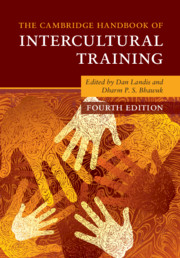Book contents
- The Cambridge Handbook of Intercultural Training
- Reviews
- The Cambridge Handbook of Intercultural Training
- Copyright page
- Dedication
- Frontispiece
- Contents
- Figures
- Tables
- Editors and Contributors
- Foreword
- Preface
- 1 Introduction and Theoretical Framework
- Part I Theoretical Foundations of Intercultural Training
- Part II Practice of Intercultural Training
- Part III Indigenous Psychology and Intercultural Training
- Part IV New Interdisciplinary Approaches to Intercultural Training
- 20 Cultural Neuroscience Basis of Intercultural Training and Education
- 21 Perceptual Representation
- 22 Emotional Contagion, Intimate Intercultural Relationships, and Intercultural Training
- 23 Dialogue and Culture
- 24 Optimizing Globalization through “Intelligent Swarming”
- Part V Summing Up
- Index
- References
22 - Emotional Contagion, Intimate Intercultural Relationships, and Intercultural Training
from Part IV - New Interdisciplinary Approaches to Intercultural Training
Published online by Cambridge University Press: 18 September 2020
- The Cambridge Handbook of Intercultural Training
- Reviews
- The Cambridge Handbook of Intercultural Training
- Copyright page
- Dedication
- Frontispiece
- Contents
- Figures
- Tables
- Editors and Contributors
- Foreword
- Preface
- 1 Introduction and Theoretical Framework
- Part I Theoretical Foundations of Intercultural Training
- Part II Practice of Intercultural Training
- Part III Indigenous Psychology and Intercultural Training
- Part IV New Interdisciplinary Approaches to Intercultural Training
- 20 Cultural Neuroscience Basis of Intercultural Training and Education
- 21 Perceptual Representation
- 22 Emotional Contagion, Intimate Intercultural Relationships, and Intercultural Training
- 23 Dialogue and Culture
- 24 Optimizing Globalization through “Intelligent Swarming”
- Part V Summing Up
- Index
- References
Summary
In recent years, scholars from a wide variety of disciplines have begun to study the process of emotional contagion. These disciplines include cultural psychology, anthropology, primatology, the neurosciences, biology, social psychology, and history. Primitive emotional contagion appears to be a basic building block of human interaction. It assists in “mind-reading” (allowing people to understand others’ thinking), sharing others’ emotions, as well as coordinating and synchronizing their activities with others.Primitive emotional contagion is also an important component of empathy. In this chapter we will discuss the many ways people can “mind-read” and feel themselves into others’ emotional experiences – especially those from disparate cultures and ethnic groups. We will also discuss the ways in which an understanding of the contagion process may be integrated into intercultural training programs. We begin by reviewing the theory of Emotional Contagion.
- Type
- Chapter
- Information
- The Cambridge Handbook of Intercultural Training , pp. 640 - 657Publisher: Cambridge University PressPrint publication year: 2020



